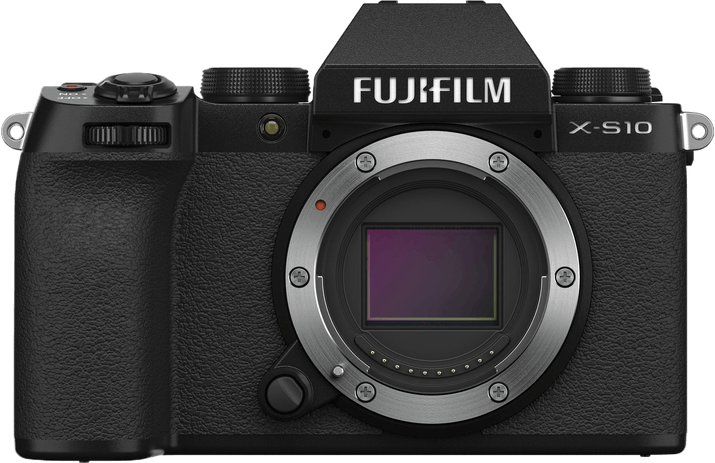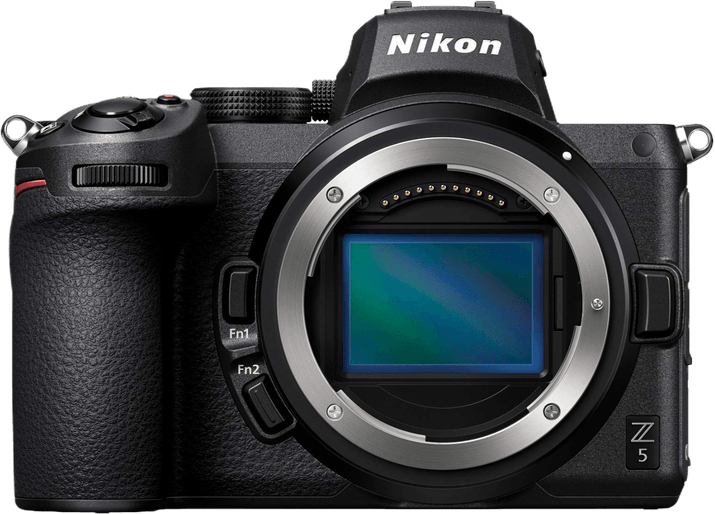Fujifilm X-S10 vs Nikon Z5 Comparison
Fujifilm X-S10

Nikon Z5

The Nikon Z5 outperforms the Fujifilm X-S10 with a score of 78/100, compared to the X-S10’s 69/100. Both cameras share similarities, such as being mirrorless and released in 2020. However, the Nikon Z5 boasts a higher launch price of $1400, while the X-S10 costs $999.
The Fujifilm X-S10 has the advantage of being more compact and lightweight, measuring 126 x 85 x 65mm and weighing 465g. In contrast, the Nikon Z5 is larger at 134 x 100.5 x 69.5mm and heavier, weighing 675g. This makes the X-S10 more portable and convenient for on-the-go photography.
Despite its size and weight, the Nikon Z5 justifies its higher score with better overall performance and features. The higher price tag reflects the camera’s superior quality, making it a better investment for professional photographers. While the Fujifilm X-S10 is more travel-friendly, the Nikon Z5 offers a more comprehensive photography experience.
Fujifilm X-S10 vs Nikon Z5 Overview and Optics
The Nikon Z5 outperforms the Fujifilm X-S10 in optics, scoring 81/100 compared to the X-S10’s 72/100. Both cameras share several common specifications, such as having a CMOS sensor, image stabilisation, and their respective lens mounts (Fujifilm X for the X-S10 and Nikon Z for the Z5).
The Nikon Z5 excels in certain areas, particularly its sensor size and DXOMARK score. The Z5 features a full-frame sensor, which provides better image quality and low-light performance compared to the X-S10’s smaller APS-C sensor. Additionally, the Z5’s sensor has a DXOMARK score of 97, indicating excellent performance, while the X-S10’s score is unavailable as DXOMARK does not evaluate Fujifilm cameras.
The Fujifilm X-S10, on the other hand, surpasses the Nikon Z5 in megapixels and shooting speed. The X-S10 has a 26-megapixel sensor, offering slightly higher resolution than the Z5’s 24-megapixel sensor. Furthermore, the X-S10 boasts a shooting speed of 20 frames per second (fps), significantly faster than the Z5’s 4.5 fps. This makes the X-S10 more suitable for capturing fast-moving subjects and continuous shooting.
In terms of processors, the X-S10 uses the X-Processor 4, while the Z5 employs the Expeed 6. Both processors are efficient and reliable, enabling quick image processing and optimal performance for their respective cameras.
Considering these factors, the Nikon Z5 stands out for its superior sensor size and performance, making it an excellent choice for photographers seeking optimal image quality. The Fujifilm X-S10, however, may be better suited for those prioritizing fast shooting speeds and higher resolution.
Fujifilm X-S10 vs Nikon Z5 Video Performance
The Fujifilm X-S10 outperforms the Nikon Z5 in video capabilities with a score of 91/100, an 8-point lead over the Nikon Z5’s score of 83/100. Both cameras share 4K video resolution and built-in time-lapse functionality, but there are key differences that contribute to the Fujifilm X-S10’s superior video performance.
The Fujifilm X-S10 boasts a max video dimension of 4096 x 2160, compared to the Nikon Z5’s 3840 x 2160. This higher resolution offers more detail and clarity in the recorded video. Additionally, the X-S10 has a significantly higher max video frame rate of 240fps, while the Nikon Z5 is limited to 60fps. This higher frame rate allows for smoother slow-motion footage and provides greater flexibility in post-production.
While the Nikon Z5 falls short in these areas, it still offers solid video performance and is a viable option for photographers who primarily focus on still images but occasionally need video capabilities. The 4K resolution and built-in time-lapse functionality are valuable features in their own right, making the Nikon Z5 a competent choice for casual video recording.
Considering the specifications and performance, the Fujifilm X-S10 is the clear winner in video capabilities. Its higher max video dimensions and superior frame rate make it a better choice for videographers or those who require more advanced video features. On the other hand, the Nikon Z5 remains a decent option for photographers who only need basic video features alongside their primary focus on still images.
Fujifilm X-S10 vs Nikon Z5 Features and Benefits
The Nikon Z5 wins the features comparison with a score of 72/100, while the Fujifilm X-S10 scores 70/100. Both cameras share several specifications, such as a touchscreen, flip screen, and Bluetooth connectivity. They also have the same screen resolution of 1,040,000 dots and lack GPS functionality.
The Nikon Z5 stands out with its larger 3.2-inch screen and built-in Wi-Fi capability. The 0.2-inch difference in screen size provides a larger view for composing and reviewing images. Wi-Fi connectivity allows users to transfer photos and control the camera remotely, making it more versatile and convenient in various shooting situations.
On the other hand, the Fujifilm X-S10 does not offer any significant advantages over the Nikon Z5 in terms of features. Both cameras have comparable specs, and the slight difference in the overall score is mainly due to the Nikon Z5’s Wi-Fi and larger screen size.
Considering the features of both cameras, the Nikon Z5 is the better option, thanks to its larger screen and Wi-Fi connectivity. These additional features make it more user-friendly and adaptable in different shooting scenarios. While the Fujifilm X-S10 is a strong contender, it falls slightly short in comparison to the Nikon Z5. Therefore, the Nikon Z5 is the recommended choice for those prioritizing camera features.
Fujifilm X-S10 vs Nikon Z5 Storage and Battery
The Nikon Z5 outperforms the Fujifilm X-S10 in storage and battery, scoring 73/100 compared to the X-S10’s 35/100. Both cameras accept SD, SDHC, and SDXC memory cards and offer USB charging. However, the Z5 has two memory card slots and is UHS-II compatible, while the X-S10 has only one slot and is UHS-I compatible. This advantage allows the Z5 to provide better storage flexibility and faster data transfer.
Additionally, the Z5 has a longer battery life with 470 shots per charge, using the EN-EL15c battery type. In contrast, the X-S10’s NP-126S battery lasts for 325 shots. The Nikon Z5’s superior battery life makes it more reliable during extended shooting sessions.
Although the Fujifilm X-S10 falls behind in storage and battery, it still offers decent performance for casual photographers. However, the Nikon Z5’s enhanced storage capabilities and longer battery life make it a more suitable choice for professionals and enthusiasts who require reliable performance and flexibility in their camera equipment.
Fujifilm X-S10 vs Nikon Z5 – Our Verdict
Are you still undecided about which camera is right for you? Have a look at these popular comparisons that feature the Fujifilm X-S10 or the Nikon Z5:

